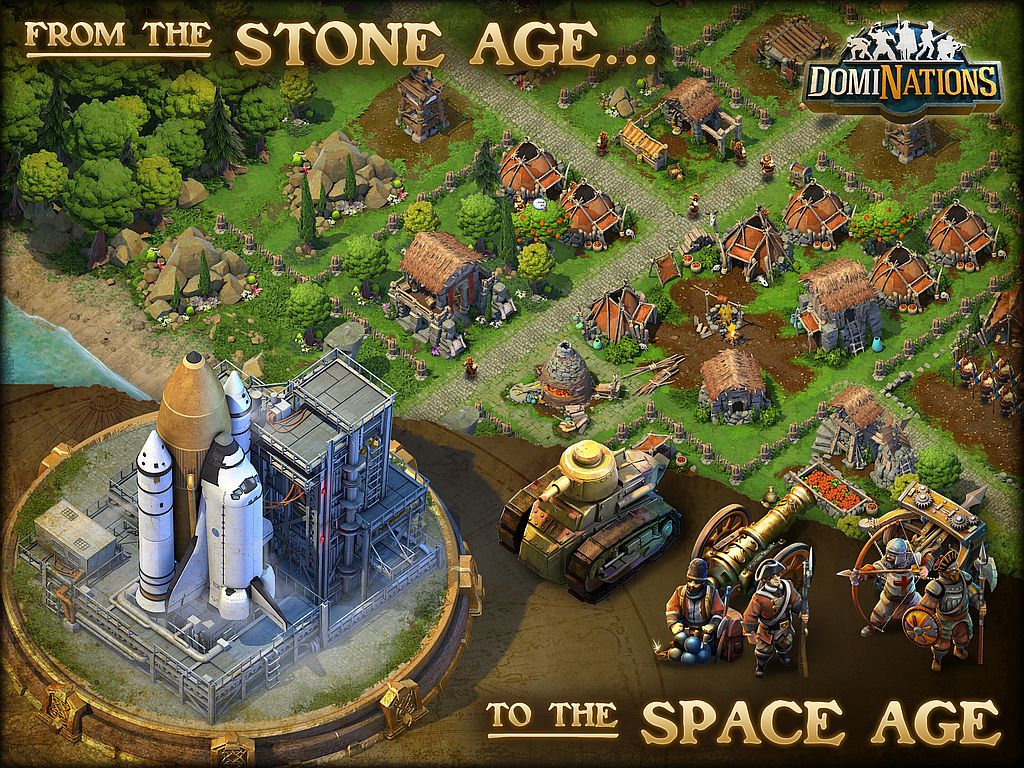The siren call of the rapidly growing mobile game business is attracting some of the game industry’s best talents. Nothing illustrates this better than the announcement today that a revived Big Huge Games led by veteran designer Brian Reynold is working on DomiNations, a mobile strategy game from the designer of such acclaimed titles as Civilization II, Rise of Nations and Rise of Legends. Reynolds worked for a time as chief game designer at Zynga, where he created social game mechanics for titles like FrontierVille and CityVille 2.
DomiNations is, in Big Huge’s words, “an epic strategic combat game of advancement, exploration and conquest” that’s being developed for phones and tablets under both iOS and Android. The game is free-to-play, and in the beloved style of classic PC strategy games, follows the rise of civilizations through time from Stone Age technology to the Space Age. Players can explore, advance and grow their civilizations while conquering the world through single-player campaign and cooperative gameplay modes. The game will be published by Nexon’s mobile gaming group, Nexon M.
“Brian and the team at Big Huge Games have built a truly epic new game with DomiNations. Strategy game fans and mobile gamers are going to love the innovation, depth, and player choice DomiNations gives each user,” said John Robinson, general manager, Nexon M.
The [a]listdaily spoke with Big Huge Games CEO, co-founder and game designer Brian Reynolds about the game and his foray into mobile games.
 Brian Reynolds
Brian Reynolds
[a]listdaily: You have created games on many platforms before this with great success. Why go mobile now for your latest game?
Brian Reynolds: I’ve worked on a lot of different platforms — PC games all the way back through DOS and Windows, console, Facebook, and now mobile. I’m platform agnostic. I see a platform as a new opportunity to make a strategy game that will have familiar elements but will also have new opportunities based on the new kind of platform. Combined with that, mobile seems to be the biggest new growth area, and I’ve always tried to go where the biggest opportunity to have the most number of players is, and that’s how I arrived at doing a mobile strategy game.
[a]listdaily: What’s been the most challenging part of developing strategy games for mobile?
Brian Reynolds: Almost always when I move from platform to platform, the main challenges that get right in your face come down to user interface issues. With mobile, unsurprisingly, that is definitely the most challenging part. If you look back at the games we did in the past, when you had a big old screen and a mouse and keyboard, that’s a very different control scheme for a game than playing on a mobile platform. You’re both looking at a much smaller display area than console and PC games of the past, and part of strategy games are about having lots of little pieces that are moving around. You’ve got to be able to visually distinguish them from each other, and you’ve also got to be able to select them accurately. That creates differences — in some cases it creates challenges and sometimes it creates opportunities.
You almost have to make your interface a lot better and a lot simpler to work well, and sometimes that leads to a surprising level of elegance or innovation that you might not have arrived at if you had a more traditional set of gaming controls. A lot of our thinking has had to relate to how do you get a really cool, fun, beautiful, deep strategy game experience that works really well on both a tablet and a phone. I’m happy with what we’ve come up with.
[a]listdaily: Are you looking for fans of PC strategy games to play DomiNations, or fans of games like Clash of Clans… or both?
Brian Reynolds: Both and all of the above and more as well, of course! The fact we’ve chosen to go back to the Big Huge Games name, we know that some of our fans from the old days will be reminded of the old games they liked. There’s no question that DomiNations is fully a free-to-play mobile strategy game, so we’re very much in that genre with Clash of Clans and Game of War. I think we’re the first to really have a go at a sweep-of-history game in that genre. I think we’ve gotten a lot of mileage out of that in the game we’ve come up with.
We’ve got the wonders of the world, you move through the ages of history. You start in the Stone age, you move through the Bronze Age and the Iron Age, the Gunpowder Age…we’ve tried to recapture that magical feeling of moving from age to age. Your buildings look different, your opportunities are different, your economy can work in a different way. We’ve tried to capture as many of those things as possible. There’s a mix of the familiar elements, for those who’ve played earlier games I’ve worked on, and there will certainly be familiar touchstones, but we’re not trying to recreate some game we did in the 90’s now. It’s a fully modern aesthetic of free-to-play mobile game design.
[a]listdaily: How does DomiNations monetize? Is the game time-gated?
Brian Reynolds: The main opportunity to spend money is for more time. You can also spend money for bandwidth, to be able to build a few more things at a time. You can unlock everything without paying any money. That makes it an even more challenging strategy game.
[a]listdaily: How did Nexon M become your publisher, and why did you select them?
Brian Reynolds: At the time I was leaving Zynga. I was looking for a way I could combine some of my knowledge from the past of building these historical strategy games with how Zynga had opened my eyes to how many more people played games. Nexon had a lot of free-to-play experience. I knew from being at Zynga you want a publisher that understands data collection and analytics. They had experience in that, and they were looking to make a move into North America and partner with some North American developers. They let us be creative in ways we want to be creative, and at the same time they have this deep wealth of F2P knowledge.
[a]listdaily: Is Big Huge Games handling the marketing for DomiNations, or is that handled by Nexon M?
Brian Reynolds: On all the strategic kinds of things that would normally be called marketing, Nexon is taking the lead and obviously we provide them with art and materials. Where you’re marketing stuff literally inside the game, that’s a Big Huge Games lead. That’s almost part of the game these days. But in terms of user acquisition, that’s on the Nexon side.
 Brian Reynolds
Brian Reynolds



